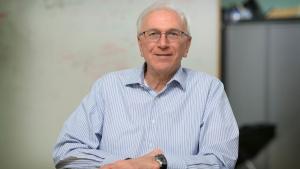
John A. “Jack” Stankovic, the BP America Professor Emeritus in the University of Virginia Department of Computer Science, can add the Institute of Electrical and Electronics Engineers’ 2024 Simon Ramo Medal to his list of professional accolades. Medals are in the top hierarchy of awards given by the IEEE.
Stankovic already has Technical Achievement Awards in three research areas recognized by the IEEE Computer Society — Real-Time Systems, Distributed Processing and Cyber-Physical Systems. For those unfamiliar with IEEE technical subfields and their award structures, this is akin to earning three lifetime achievement awards for research.
His citation for the Simon Ramo Medal recognizes each of these areas: “For contributions to the theory of real-time and resource-constrained, distributed systems and the practice of cyber-physical and health systems.”
“I’m grateful to receive this recognition and the biggest reason is that it validates all the work my students, colleagues and I have done and continue to do to build systems that make life better for people,” Stankovic said.
Blazing Trails, From Real-Time Computing to ‘Smart’ Technologies
Stankovic gained prominence in 1988 with his seminal paper, “Misconceptions About Real-Time Computing: A Serious Problem for Next-Generation Systems.”
Real-time systems collect and process data to deliver accurate results within task-specific deadlines that change depending on inputs. These deadlines were and are necessary for the safe operation of increasingly complex systems, from medical devices such as anesthesia machines or pacemakers to autonomous vehicles.
“These timing requirements are technically multifaceted, difficult to achieve, and potentially catastrophic if the system fails to meet them,” Stankovic said. “At the time, I felt people were trying to make real-time systems work while not focusing enough on the scientific underpinnings needed to make them work on time and correctly.”
His paper articulated the need for more fundamental research and led to real-time computing becoming a new computer science subfield.
Since then, he’s been at the forefront of other nascent fields, including “smart” technologies such as cyber-physical systems, where sensors and actuators in the physical world interact with computer systems to help people. Advancements in this area are why you can rely on the automatic breaking system in your car or your smartwatch alerting your doctor of a cardiac event.
His recent cyber-physical research includes a smart health system providing Alzheimer’s patient caregivers a way to manage stress using audio detection software and prompts delivered to the user’s cellphone.
Among his significant research programs was VigilNet, partially funded by DARPA, the Defense Advanced Research Projects Agency, in which his UVA team built a real-time battlefield surveillance system involving wireless sensor networks — technologies entailing both real-time and distributed systems problems that Stankovic had helped develop, such as wireless communications, power management and security.
Shaping Cyber-Physical Research and Education
In 2005, Stankovic co-authored “Opportunities and Obligations for Physical Computing Systems,” which predicted a “technical, economic, and social revolution” predicated on access to “data and services that will be available any place, any time, to all people, not just technically sophisticated organizations and individuals.”
Within a few years of the paper’s publication, the National Science Foundation created a dedicated funding program for cyber-physical systems, and Stankovic helped define the research program’s scope.
Stankovic, a member of the National Academy of Engineering Computer Science and Telecommunications Board, also co-chaired the NAE’s Committee on 21st Century Cyber-Physical Systems Education, contributed to another seminal paper, “Cyber-Physical Systems: The Next Computing Revolution,” and authored “Research Directions for the Internet of Things,” which has been cited more than 2,400 times, according to Google Scholar.
His more than 400 papers have earned two test-of-time and nine best paper awards, plus 11 runners-up, and he’s been cited nearly 68,000 times. He was the editor-in-chief for the IEEE Transactions on Distributed and Parallel Systems and was founder and co-editor-in-chief for the Real-Time Systems Journal and the Association for Computing Machinery’s Transactions on Computing for Healthcare.
Stankovic’s numerous distinctions also include an honorary doctorate from Britain’s University of York, election to the Virginia Academy of Science, Engineering and Medicine, UVA’s Distinguished Scientist Award and the Distinguished Faculty Award from the University of Massachusetts, where he began his academic career.
Stankovic, who recently retired, mentored 48 Ph.D. students and eight postdocs. He served as chair of UVA’s Department of Computer Science from 1997 to 2004 and was a co-founder and director of Link Lab, UVA Engineering’s multidisciplinary center for cyber-physical research.
The Simon Ramo Medal, given for “exceptional achievement in systems engineering and systems science,” neatly ties together the strands of Stankovic’s varied career, throughout which his research has been guided by an essential question.
“You have to ask, how does the real world influence your software and vice versa?” Stankovic said. “Algorithms are based on data, and if the data’s based on nonreal-world situations, what good is it? After all, we design technology for people, not just to discover what’s theoretically possible.”